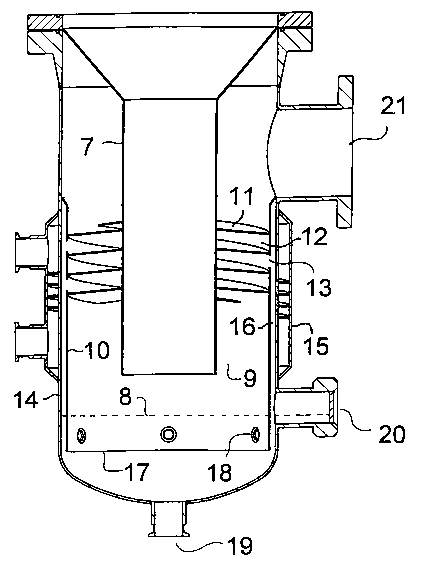Some of the information on this Web page has been provided by external sources. The Government of Canada is not responsible for the accuracy, reliability or currency of the information supplied by external sources. Users wishing to rely upon this information should consult directly with the source of the information. Content provided by external sources is not subject to official languages, privacy and accessibility requirements.
Any discrepancies in the text and image of the Claims and Abstract are due to differing posting times. Text of the Claims and Abstract are posted:
| (12) Patent Application: | (11) CA 2422943 |
|---|---|
| (54) English Title: | METHOD AND DEVICE FOR THE PRODUCTION OF PURE STEAM |
| (54) French Title: | PROCEDE ET APPAREIL DE PRODUCTION DE VAPEUR PURE |
| Status: | Deemed Abandoned and Beyond the Period of Reinstatement - Pending Response to Notice of Disregarded Communication |
| (51) International Patent Classification (IPC): |
|
|---|---|
| (72) Inventors : |
|
| (73) Owners : |
|
| (71) Applicants : |
|
| (74) Agent: | OSLER, HOSKIN & HARCOURT LLP |
| (74) Associate agent: | |
| (45) Issued: | |
| (86) PCT Filing Date: | 2001-09-19 |
| (87) Open to Public Inspection: | 2002-03-28 |
| Examination requested: | 2006-08-29 |
| Availability of licence: | N/A |
| Dedicated to the Public: | N/A |
| (25) Language of filing: | English |
| Patent Cooperation Treaty (PCT): | Yes |
|---|---|
| (86) PCT Filing Number: | PCT/FI2001/000810 |
| (87) International Publication Number: | WO 2002024299 |
| (85) National Entry: | 2003-03-21 |
| (30) Application Priority Data: | ||||||
|---|---|---|---|---|---|---|
|
A method and a device for the production of pure steam, wherein steam produced
in downflow evaporation tubes is carried upwards in a spiraling path. In the
outer wall of the spiral path, openings are provided for capturing droplets
carried to the wall by centrifugal force. A radial flow through the openings
is generated as steam condenses on a cooled surface outside the openings.
Impurities are enriched in the water phase that forms on the cooled surface,
and the water phase flows downwards by gravity to form a pool of reject water,
a flow of which is constantly removed from the process. Pure steam is
withdrawn from above the spiral path.
L'invention concerne un procédé et un dispositif de production de vapeur pure, dans lequel la vapeur produite dans des tubes d'évaporation à courant descendant est entraînée vers le haut dans un chemin en spirale. La paroi extérieure du chemin en spirale comporte des ouvertures qui attirent les gouttes amenées sur la paroi sous l'action de la force centrifuge. Un écoulement radial traversant les ouvertures et transformé en vapeur se condense sur une surface refroidie à l'extérieure des ouvertures. La phase aqueuse qui se forme sur la surface refroidie est riche en impuretés. Elle s'écoule vers le bas sous l'action de la gravité pour former une masse d'eau de rejet dont un courant est régulièrement éliminé du processus. La vapeur pure obtenue est extraite en haut du chemin en spirale.
Note: Claims are shown in the official language in which they were submitted.
Note: Descriptions are shown in the official language in which they were submitted.

2024-08-01:As part of the Next Generation Patents (NGP) transition, the Canadian Patents Database (CPD) now contains a more detailed Event History, which replicates the Event Log of our new back-office solution.
Please note that "Inactive:" events refers to events no longer in use in our new back-office solution.
For a clearer understanding of the status of the application/patent presented on this page, the site Disclaimer , as well as the definitions for Patent , Event History , Maintenance Fee and Payment History should be consulted.
| Description | Date |
|---|---|
| Inactive: Agents merged | 2013-10-24 |
| Application Not Reinstated by Deadline | 2008-09-19 |
| Time Limit for Reversal Expired | 2008-09-19 |
| Deemed Abandoned - Failure to Respond to Maintenance Fee Notice | 2007-09-19 |
| Amendment Received - Voluntary Amendment | 2006-10-05 |
| Letter Sent | 2006-09-27 |
| Request for Examination Received | 2006-08-29 |
| All Requirements for Examination Determined Compliant | 2006-08-29 |
| Request for Examination Requirements Determined Compliant | 2006-08-29 |
| Inactive: IPC from MCD | 2006-03-12 |
| Letter Sent | 2003-07-29 |
| Inactive: Single transfer | 2003-06-10 |
| Inactive: Courtesy letter - Evidence | 2003-06-03 |
| Inactive: Cover page published | 2003-05-30 |
| Inactive: Notice - National entry - No RFE | 2003-05-28 |
| Application Received - PCT | 2003-04-16 |
| National Entry Requirements Determined Compliant | 2003-03-21 |
| Application Published (Open to Public Inspection) | 2002-03-28 |
| Abandonment Date | Reason | Reinstatement Date |
|---|---|---|
| 2007-09-19 |
The last payment was received on 2006-09-12
Note : If the full payment has not been received on or before the date indicated, a further fee may be required which may be one of the following
Please refer to the CIPO Patent Fees web page to see all current fee amounts.
| Fee Type | Anniversary Year | Due Date | Paid Date |
|---|---|---|---|
| Basic national fee - standard | 2003-03-21 | ||
| Registration of a document | 2003-06-10 | ||
| MF (application, 2nd anniv.) - standard | 02 | 2003-09-19 | 2003-09-09 |
| MF (application, 3rd anniv.) - standard | 03 | 2004-09-20 | 2004-09-16 |
| MF (application, 4th anniv.) - standard | 04 | 2005-09-19 | 2005-09-02 |
| Request for examination - standard | 2006-08-29 | ||
| MF (application, 5th anniv.) - standard | 05 | 2006-09-19 | 2006-09-12 |
Note: Records showing the ownership history in alphabetical order.
| Current Owners on Record |
|---|
| STERIS EUROPE INC. SUOMEN SIVULIIKE |
| Past Owners on Record |
|---|
| MAURI SALMISUO |